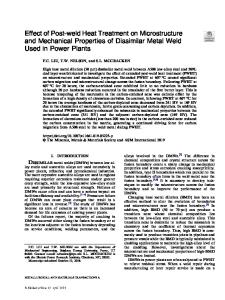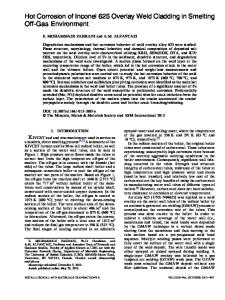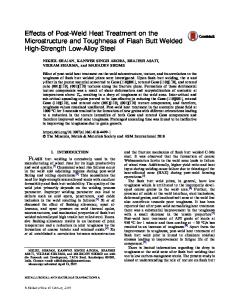Microstructure and electrochemical behavior of stainless steel weld overlay cladding exposed to post weld heat treatment
- PDF / 995,038 Bytes
- 11 Pages / 584.957 x 782.986 pts Page_size
- 22 Downloads / 362 Views
P. Zhu Remanufacturing and Electric Power Safety Center, Suzhou Nuclear Power Research Institute Co. Ltd., Suzhou 215004, China
T.G. Liu and Y.H. Lua) National Center for Materials Service Safety, University of Science and Technology Beijing, Beijing 100083, China
T. Shoji National Center for Materials Service Safety, University of Science and Technology Beijing, Beijing 100083, China; and Fracture and Reliability Research Institute, Tohoku University, Sendai 980-8579, Japan (Received 1 October 2016; accepted 21 December 2016)
Microstructure and electrochemical behavior of stainless steel weld overlay cladding exposed to post weld heat treatment (PWHT) were investigated, wherein pitting and intergranular corrosion behaviors of the cladding material were evaluated by potentiodynamic polarization and double loop electrochemical potentiokinetic reactivation methods. The results indicated that inclusions, multiple element (Mn, Si, and Al) oxides distributed randomly in the cladding material with a size less than 1 lm. PWHT contributed to carbides precipitation along the d/c phase interface and the formation of Cr-depleted zone in the austenite phase. Inclusions acted as the pitting sites in the sample as welded. PWHT reduced the pitting potential and contributed to the formation of larger and deeper pits, which nucleated around the d/c phase interface primarily. Existence of carbides and Cr-depleted zone dominated the loss of intergranular corrosion resistance after PWHT.
I. INTRODUCTION
Due to outstanding mechanical and corrosion properties, stainless steel exhibits a tremendous advantage in many industries and a duplex structure (austenite and ferrite phases) promotes the stability and weldability of these materials further by lowering the possibility of hot cracking,1–3 while defects, microsegregation, and residual stress are easily to be generated during welding process,4 for the stainless steel cladding material, post weld heat treatment (PWHT) in range of 600–650 °C is widely chosen to mitigate these negative effects and the good welding properties are obtained.5,6 It is taken for granted that the content of Cr element is the key factor to the passive film and the corrosion resistance basically.7 For stainless steel, a higher Cr content ensures the better corrosion resistance of materials while grain size,8 alloying elements,9 and second phases10–14 such as inclusions, carbides, and r-phase damage the stabilization of passive film, which results in the degradation of corrosion properties. Some previous works indicate that three types of the inclusions (MnS, multielement oxides, and mixtures of sulfides and oxides) have Contributing Editor: Jürgen Eckert a) Address all correspondence to this author. e-mail: [email protected] DOI: 10.1557/jmr.2016.526
been studied and each type of the inclusions shows the different response to pitting nucleation and growth,12,13 while the type of the inclusion and its effects on corrosion properties have not been fully understood for the cladding material. It is widel
Data Loading...










